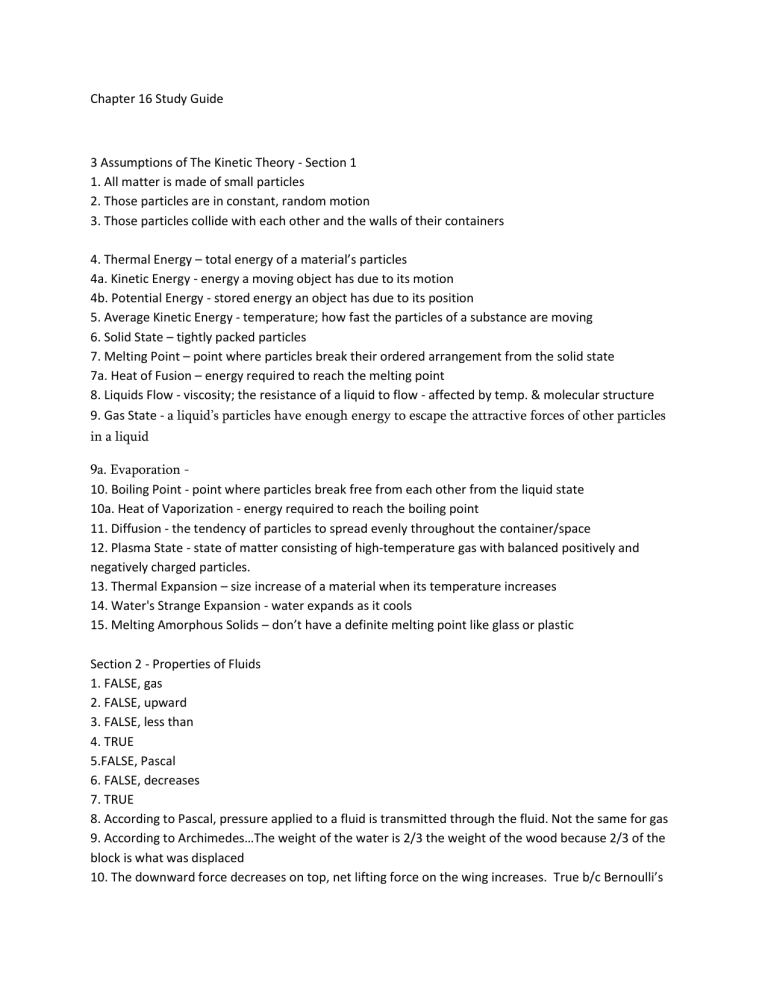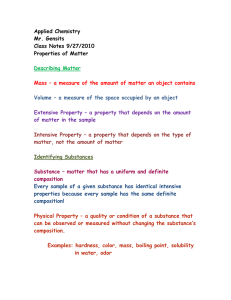Chapter 16 Study Guide - ANSWERS

Chapter 16 Study Guide
3 Assumptions of The Kinetic Theory - Section 1
1. All matter is made of small particles
2. Those particles are in constant, random motion
3. Those particles collide with each other and the walls of their containers
4. Thermal Energy – total energy of a material’s particles
4a. Kinetic Energy - energy a moving object has due to its motion
4b. Potential Energy - stored energy an object has due to its position
5. Average Kinetic Energy - temperature; how fast the particles of a substance are moving
6. Solid State – tightly packed particles
7. Melting Point – point where particles break their ordered arrangement from the solid state
7a. Heat of Fusion – energy required to reach the melting point
8. Liquids Flow - viscosity; the resistance of a liquid to flow - affected by temp. & molecular structure
9. Gas State - a liquid’s particles have enough energy to escape the attractive forces of other particles in a liquid
9a. Evaporation -
10. Boiling Point - point where particles break free from each other from the liquid state
10a. Heat of Vaporization - energy required to reach the boiling point
11. Diffusion - the tendency of particles to spread evenly throughout the container/space
12. Plasma State - state of matter consisting of high-temperature gas with balanced positively and negatively charged particles.
13. Thermal Expansion – size increase of a material when its temperature increases
14. Water's Strange Expansion - water expands as it cools
15. Melting Amorphous Solids – don’t have a definite melting point like glass or plastic
Section 2 - Properties of Fluids
1. FALSE, gas
2. FALSE, upward
3. FALSE, less than
4. TRUE
5.FALSE, Pascal
6. FALSE, decreases
7. TRUE
8. According to Pascal, pressure applied to a fluid is transmitted through the fluid. Not the same for gas
9. According to Archimedes…The weight of the water is 2/3 the weight of the wood because 2/3 of the block is what was displaced
10. The downward force decreases on top, net lifting force on the wing increases. True b/c Bernoulli’s
Law says as velocity of fluid or gas increases, pressure exerted by fluid or gas decreases.
Section 3 -
1. Boyle's Law – Volume increases as pressure increases if temperature held constant. At a constant pressure, volume decreases as temperature decreases.
2. Charles' Law – volume and temperature are directly proportional. Go up together, go down together.
3. pressure – moving particles collide with the inside walls of a container.
4. absolute zero - particle motion so slow that no thermal energy can be removed from the substance.
5. If temperature is constant and you decrease the volume of the container that holds it, pressure will increase.
6. If the volume of a container of gas remains constant and you increase the temperature, pressure will increase.
7. Freezing point of water in K: 273 K
8. Boiling point of water in K: 373 K
9. Freezing point of water in C: 0 C ; Boiling point of water in C: 100 C






